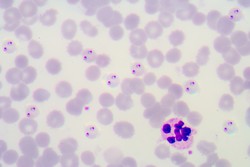Fast and easy malaria diagnosis
According to the World Health Organisation, about half of the world's population is at risk of contracting malaria. It represents a global health priority with an estimated 212 million cases worldwide and approximately 430 000 deaths in 2015. With EU funding, the project NANOMAL (Development of a handheld antimalarial drug resistance diagnostic device using nanowire technology) further developed a simple-to-use, affordable tool to analyse malaria infection and mutations in malarial DNA. The device will enable the treatment of the specific malaria parasite while assessing the real-time risk of drug resistance emergence and the impact of antimalarial interventions. The affordable device, capable of delivering a diagnosis within 20 minutes of sampling from a finger prick of blood, has been integrated with cell phone technology. The system will support remote consultations and transfer of data to central processing centres for global tracking to support appropriate treatment and improved outcomes. The NANOMAL device works by extracting and amplifying DNA from the sample and binding it to probes immobilised on the surface of the electronic biosensors. This assay will detect all five species of human malaria, including the most dangerous, most common and newest. Furthermore, the assay will also detect more than 10 mutations associated with drug resistance in the most dangerous species. Components have been integrated into the portable device and the disposable malaria assay cartridge will be ready for commercialisation in 2018. The device has undergone an extended period of optimisation and miniaturisation using parasite DNA samples and laboratory testing with clinical samples. The tremendous potential of the NANOMAL device has been recognised as the number one innovation in malaria elimination by The Guardian's Global Development Professionals Network. It brings the appropriate diagnosis and life-saving intervention for malaria to underserved regions of the globe.
Keywords
Malaria diagnosis, drug resistance, portable, NANOMAL, diagnostic device, malarial DNA



